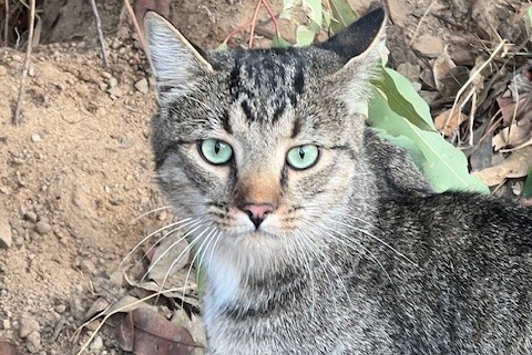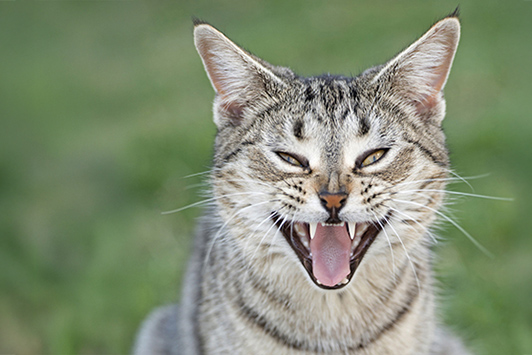
Feral cats are defined as cats that are living and reproducing in the wild. They are not owned or socialised and survive on their own in the wild by hunting and scavenging.
Cats are not native to Australia. They arrived with European settlers and were later introduced to control rabbits and rodents. Many domestic cats have also become independent of their owners and bred to become feral.
Damage caused by feral cats
A Department of Biodiversity, Conservation and Attractions review of Western Australia’s threatened and priority fauna species found that that 36 mammal, 22 bird, and 11 reptile species are vulnerable to predation by feral cats and a wide range of other native animals are adversely affected by them.
Australia-wide, feral cats have contributed to the extinction of more than 20 mammal species and are a recognised threat to over 200 nationally threatened species, and 37 listed migratory species (Source: Australian Government, Department of Climate Change, Energy, the Environment and Water, Feral cats).
Feral cats are recognised by the Environment Pests and Invasives Committee as an extreme threat category for Australia (the highest threat) (IPAC 2015). Predation by feral cats is recognised as a key threatening process under the Environmental Protection and Biodiversity Conservation Act 1999.
Department of Biodiversity, Conservation and AttractionsDistribution
Feral cats are found across Western Australia in habitats including forests, woodlands, grasslands, wetlands, and arid areas.
Biology
Feral cats are the same species as domestic cats but differ in how and where they live.
Diet
Feral cats are carnivores and can survive with limited access to water as they acquire most of their water from their prey and are not dependent on daily access to fresh water.
They generally eat small mammals, but also catch birds, reptiles, amphibians, fish, and insects – taking prey up to the size of a brush-tail possum.
In pastoral regions, they feed largely on young rabbit, but in other areas, feral cats prey mainly on native animals.
Reproduction
Males reach sexual maturity at 8 to 10 months of age and females from 6 to 8 months. Feral cats have no defined breeding period and can have 2 to 3 litters per year. Each litter consists of 3 to 4 kittens; however, survival rate is low. They live on average for 5 years, as opposed to domestic cats that live on average 9 to 15 years.
Feral cats breed successfully in the Australian landscape, meaning many feral cats have never known or interacted with humans. Feral cats are now present across 99.8% of Australian and can weigh up to 9 kg.
Who manages ferals cats?
The Department of Biodiversity, Conservation and Attractions (DBCA) primarily focuses on managing feral cats where they impact biodiversity and conservation values, such as threatened fauna species, including chuditch (Western quoll) and numbats.
Control
Feral cats are a declared pest in Western Australia under the Biosecurity and Agriculture Management (BAM) Act 2007. This provides a mechanism for effective and humane management of this pest animal to reduce numbers in a sustained manner.
Recognised control methods for feral cats include exclusion fencing, baiting, trapping using cage traps, and shooting.
Trapping cats
Trapping feral cats using cage traps allows the captured animals to be inspected for a collar and registration tag, and scanned for a microchip, ensuring the identification of domestic cats.
Shooting and baiting
Strict rules apply to shooting and baiting. Baits containing the toxin 1080 can only be used by authorised officers, Licensed Pest Management Technicians, and approved users. They must operate under a Code of Practice for the Safe Use and Management of Registered Pesticides containing 1080, PAPP and Strychnine, available on the Department of Health website and relevant legislation.
Use of firearms must comply with relevant legislation and accompanying regulations.
For more information on feral cat control methods, refer to the Policy statement on minimising risk to domestic cats, linked under Documents on this page.
Animal welfare consideration
Control of feral cats must be humane and undertaken in accordance with the Animal Welfare Act 2002, and reasonable care must be taken to ensure other animals are not harmed. It is an offence under the Act to be cruel or cause unnecessary harm to an animal, including declared pests. Penalties of up to $50,000 and imprisonment for 5 years apply to an offence.
Documents
-
Feral cat questions and answerspdf (170 KB)
-
Policy statement on minimising risk to domestic catspdf (382 KB)
Related content
- Declared pests
- Pest mammals
- Department of Biodiversity, Conservation and Attractions (dbca.wa.gov.au)
- Code of Practice for the Safe Use and Management of Registered Pesticides containing 1080, PAPP and Strychnine | Department of Health, Western Australia (health.wa.gov.au)
- Environmental Protection and Biodiversity Conservation Act 1999 | Australian Government (legislation.gov.au)
- Biosecurity and Agriculture Management (BAM) Act 2007 | Western Australian Government (legislation.wa.gov.au)
- Animal Welfare Act 2002 | Western Australian Government (legislation.wa.gov.au)

